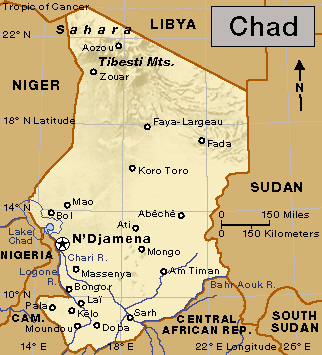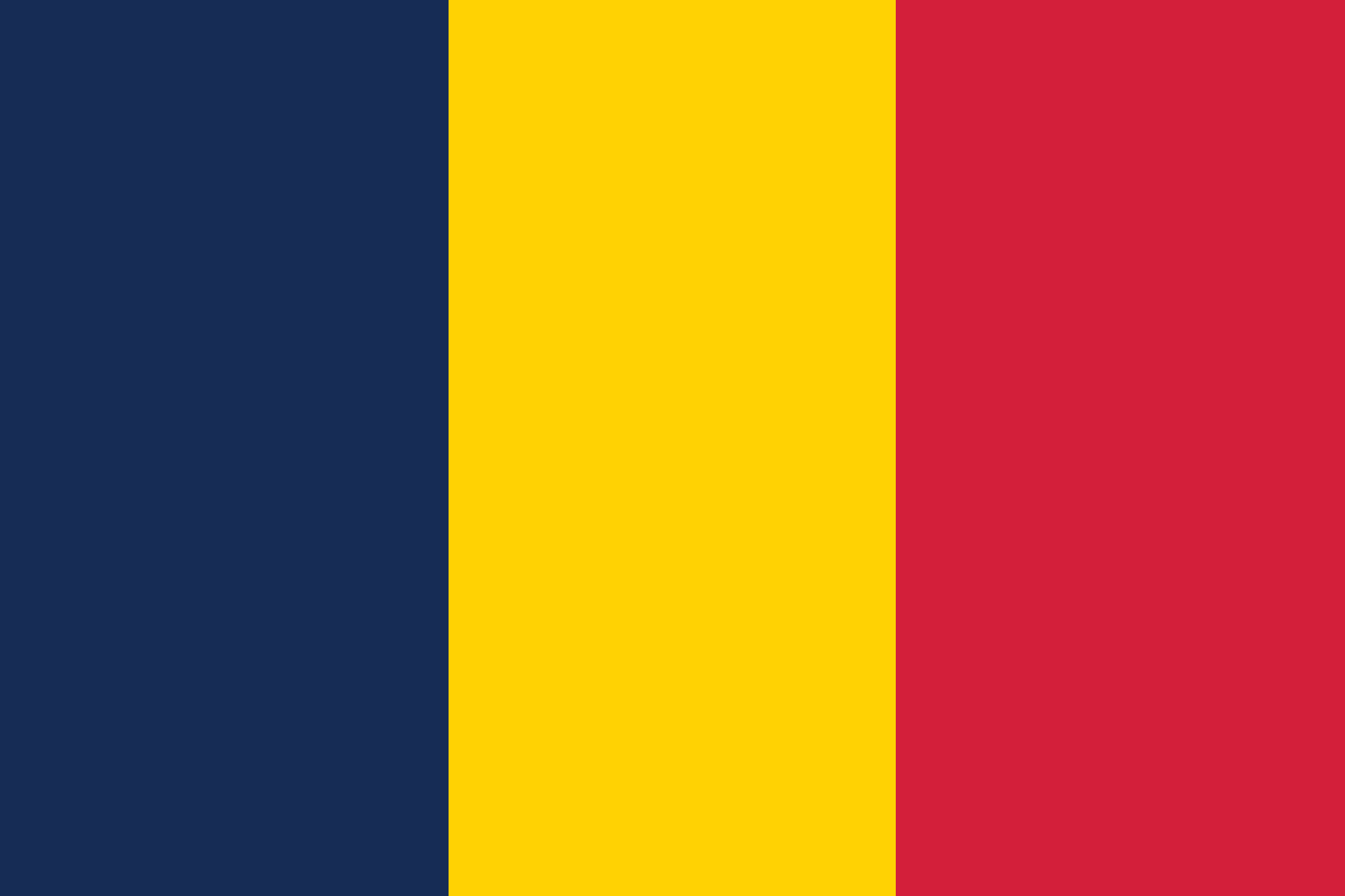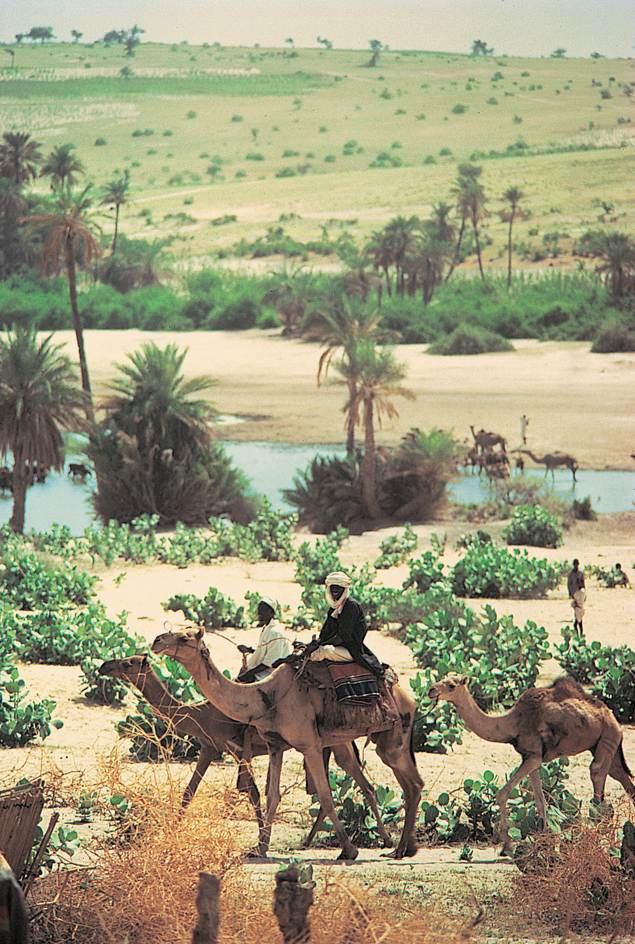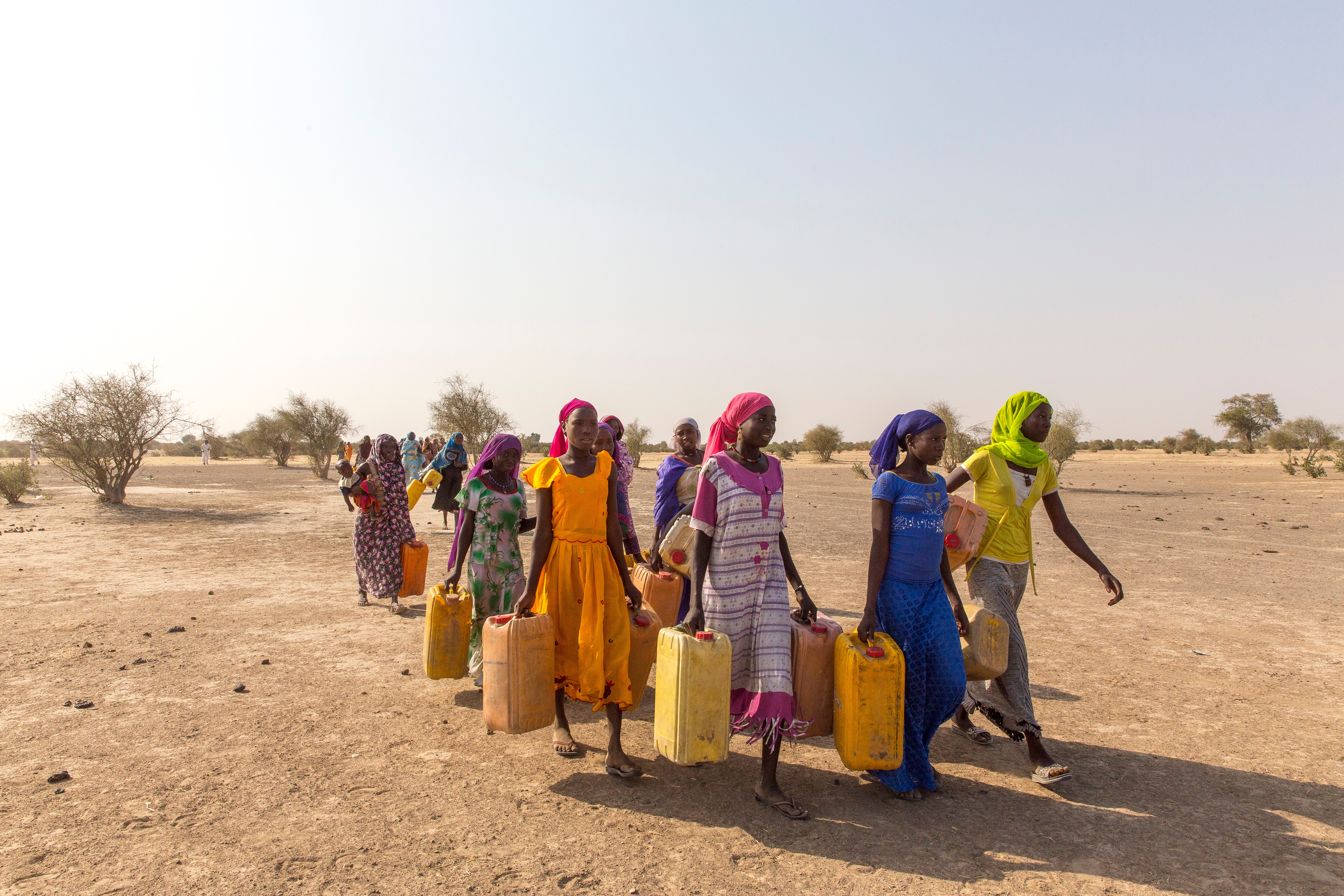Chad is a large, thinly populated country in north-central Africa. Chad is landlocked—that is, it has no borders on the sea. Most of its people live in the fertile southern part of the country. The northern part is mostly desert. N’Djamena is the capital and largest city. Ruled by France after 1920, Chad became an independent nation in 1960.

Since the mid-1960’s, much of Chad’s history has been marked by ethnic, religious, and political violence. Most conflicts have been between the Muslim peoples of the north and the peoples of the south, many of whom follow traditional African religions or Christianity. This fighting, along with other factors such as high energy costs and the country’s landlocked location, have made Chad one of the world’s least developed nations. However, Chad began to develop its oil resources in 2000, and oil exports began in 2004.
Government.
The president of Chad is the head of state and head of government. The people elect the president to a five-year term. The president appoints a Cabinet, an advisory group that helps the president. The National Assembly makes the laws. Assembly members are elected to four-year terms. The Supreme Court is Chad’s highest court.

Chad is divided into 23 local government regions. Local authority rests with traditional chiefs in some areas and with officials appointed by the national government in other areas.
People.
The people of Chad, called Chadians, belong to a variety of ethnic groups. French and Arabic are the official languages, but most Chadians speak their own local languages. Most of the adults in Chad cannot read and write.
Most Chadians live in the countryside and work as farmers or nomadic (wandering) herders—that is, herders who move with the seasons to find pastures for their flock. The rest live in N’Djamena and a few other cities. Many of these people also work as farmers nearby.
In northern Chad, most of the people are Arabs or members of the African Toubou ethnic group. Most of these people are cattle traders. They travel through the desert in small bands with herds of livestock. They make tents out of sticks and woven mats. The men of northern Chad usually wear loose gowns and turbans or small skullcaps. Some men also wrap long, white scarves around their faces for protection during sandstorms. The women typically wrap themselves in light blue or black one-piece robes.
Northern Chadians raise cattle, camels, goats, and sheep. Milk and meat are the basis of their diet. The northerners also eat dates and vegetables that are grown in oases and villages. Arabic is the most common language spoken in northern Chad, and a majority of the people in the region are Muslims. Less than a tenth of the school-age children in the north attend school.
Most of the people in southern Chad are Africans from various ethnic groups. The largest of these groups, the Sara, live chiefly in the far south.
Most southern Chadians are settled farmers. Their main cash crop is cotton. They live in circular houses made of adobe brick or dried mud covered with a straw roof. Some houses are made entirely of straw. The men usually wear cotton trousers or shorts and loose shirts. Women commonly dress in brightly colored blouses and one-piece skirts. The diet of southerners consists mainly of millet, sorghum, and rice. Meals occasionally include vegetables, fish, or meat. 
Sara is the most widely spoken language in the south, but there are many others. The majority of southern Chadians follow traditional African religions, but many have converted to Christianity. The missionaries who introduced Christianity in the region also started the school system. Education has helped the south gain a dominant position in Chad. Most of Chad’s primary and secondary schools are in areas where the Sara live. Most business people, teachers, traders, and government workers come from that region. The south also contains most of Chad’s cities and industries.
The tremendous gap in education and economic development has added to the conflict between residents of the north and south. Northerners feel they lack the opportunity to advance in education, business, and other aspects of life. Religious differences between Muslims and Christians have added to this tension.
Land and climate.
Most of the country consists of arid desert land and rocky plateaus. The Tibesti mountain range in northwestern Chad includes the country’s highest point, Emi Koussi. This mountain rises 11,204 feet (3,415 meters) above sea level. A flat stretch of savanna (grassland with scattered trees) in central Chad separates the vast desert in the north from a small, extremely fertile region in the south.

Southern Chad covers the area south and southeast of the Chari River. It was called “Useful Chad” by French colonists because it has all the advantages that northern Chad lacks. Its soil and climate are ideal for cultivating cotton, and it is by far Chad’s richest farming region. This tropical forested region also has a rich supply of wild animals, including antelope, elephants, lions, and giraffes. These animals can be seen in Zakouma National Park, northeast of Sarh.
Chad has several rivers, most of them in the south. The largest of these, the Chari and the Logone, meet at N’Djamena and then flow into Lake Chad. The lake’s size varies greatly between rainy and dry seasons. Crocodiles, hippopotamuses, and cranes live in the marshy area around the lake.
Temperatures in the northern desert often reach 120 °F (49 °C), and the region receives less than 5 inches (13 centimeters) of rain annually. Central Chad averages 25 inches (64 centimeters) of rain each year, while southern Chad receives about 40 inches (100 centimeters). The average temperature in these two regions is 82 °F (28 °C).
Economy.
Despite recent growth, Chad remains an underdeveloped country. Many of the country’s people live in poverty. Other countries and private organizations concerned about the famines in Chad have donated emergency food and economic aid. Remittances (money sent home) from Chadians working abroad is also a helpful source of national income.
The country has been working to develop its oil resources. In the early 2000’s, the World Bank and the U.S. oil company Exxon Mobil Corporation funded construction of a pipeline from southern Chad through Cameroon to the Gulf of Guinea. In return, Chad agreed to use most of the oil revenues for social development projects. Today, oil is by far the country’s leading export. In addition to oil, Chad also mines natron (a natural salt used as a preservative) near Lake Chad, as well as gold and stone. The country also has deposits of bauxite, titanium, and uranium.
Traditional agriculture, fishing, and livestock raising employ over half of Chad’s workers. Crops are mainly raised in the south, while livestock is raised in the north. Farmers grow cassava, corn, cotton, gum arabic, millet, peanuts, rice, sorghum, and yams. They also raise beef and dairy cattle, camels, goats, and sheep. Chad suffers from occasional severe droughts, which have destroyed crops and livestock and caused many deaths. Fishing in the Chari and Logone rivers and Lake Chad is a seasonal activity. 
Manufacturing plays a small role in Chad’s economy. The chief manufactured products include beer, cigarettes, construction materials, and cotton products. N’Djamena has an oil refinery.
In addition to oil, Chad also exports cotton, gold, gum arabic, and livestock. Imports include food products, industrial goods, machinery, and transportation equipment. Chad’s chief trading partners include Cameroon, China, France, and the United States.
Poor transportation and communications facilities are obstacles to Chad’s economic development. The country has no railroads, and almost all its roads are unpaved. N’Djamena has an international airport. The government owns the country’s only television station and main radio station. Other radio stations are privately owned.
History.
Little is known about Chad’s earliest history. Remains of prehistoric civilizations have been discovered in the Tibesti, Borkou, and Ennedi regions in northern Chad. Rock engravings and paintings dating back to 5000 B.C. show hunting and herding scenes. Primitive tools found around Lake Chad point to the existence of cattle-raising peoples as early as 500 B.C. Developing trade routes led to the formation of a state called Kanem northeast of Lake Chad in the A.D. 700’s. A series of kings from the Sefuwa family ruled Kanem for about 1,000 years. Islam was introduced around 1100.
The smaller kingdoms of Baguirmi and Ouaddai developed near Kanem in the 1500’s and 1600’s. All three kingdoms became powerful and prosperous by trading goods and enslaved people. Traders from the northern kingdoms often raided the southern tribes to capture and enslave the captives. One reason for the conflict in Chad today is that the Sara people remember that northern raiders seized thousands of their people and enslaved them.
The French claimed and explored Chad during the 1880’s and 1890’s. Chad became a French colony in 1920 and was part of a region called French Equatorial Africa. See French Equatorial Africa.
The Sara people suffered more than any other group under colonial rule. Many died in battle in World War I (1914-1918) and World War II. Thousands were sent to work on a railway in what is now the Republic of the Congo and never returned. But when Chad became independent in 1960, a Sara-dominated government took over. For the Sara, independence also meant freedom from the age-old domination by northern slave traders. François Tombalbaye, a Sara leader, became Chad’s first president.
In 1966, a group of northerners formed a rebel organization called the National Liberation Front of Chad (Front de Libération Nationale du Tchad), or Frolinat. Most of its leaders were Muslims. Civil war between Frolinat and government troops broke out in the mid-1960’s. The government of Chad turned to France for military aid. In 1971, Frolinat began to get military supplies from Libya, and the Libyan government became deeply involved in Chad’s internal affairs. In 1973, Libyan forces occupied the Aozou Strip along Chad’s northern border. This area is believed to contain uranium and other minerals.
President Tombalbaye was killed in 1975 by military and police units that overthrew the government. Félix Malloum, a Sara and the head of Chad’s army, became president of the new military regime. Fighting continued until the rebels captured almost half the Chadian army in 1978. A new government was then formed with almost an equal number of representatives from the north and the south. Hissène Habré, a former Frolinat leader, became prime minister.
After the new government failed to solve Chad’s problems, President Malloum fled in 1979, and two rebel groups battled for control. One group followed Habré, then minister of defense. The other group was headed by the new president, Goukouni Oueddei. Goukouni received support from Libya. In 1980, the army led by Habré was defeated by Goukouni’s troops and Libyans who aided them. Goukouni took control of the government. Libyan troops remained in Chad until late 1981 when Goukouni asked them to leave. A peacekeeping force from the Organization of African Unity (OAU) replaced the Libyan troops.
In June 1982, an army led by Habré overthrew the government of President Goukouni. Goukouni fled the country, and the OAU peacekeeping force withdrew. Habré became president, but Goukouni returned with troops from Libya. In 1983, France sent troops and military equipment to support Habré. Goukouni’s forces and Libyan troops occupied the northern part of Chad, while Habré’s forces controlled N’Djamena.
In 1986, conflict broke out between Goukouni’s troops and their Libyan allies. Goukouni’s troops joined with Habré’s forces, and Habré launched attacks against the Libyans. In 1987, the Libyans withdrew into the Aozou Strip and agreed to a truce. Libya pulled out of the Aozou Strip in 1994 after the United Nations International Court of Justice ruled that the area belonged to Chad.
In 1990, a rebel group called the Patriotic Salvation Movement (Mouvement Patriotique du Salut, or MPS), led by Idriss Déby, overthrew Habré’s government. A national conference of political parties and other groups set up an interim government in 1993. In 1996, Chad adopted a new constitution and held a multiparty presidential election, which Déby won. The country held legislative elections in 1997, and the MPS won a majority of the seats. Déby was reelected president in 2001, and the MPS remained in power after legislative elections in 2002.
In 1998, the Movement for Democracy and Justice in Chad rebelled against the government. Although the government and the rebels signed several peace agreements, sporadic violence continued until late 2003. In 2006, Déby was reelected president in disputed elections. Rebel uprisings reignited in 2006 and 2007, and the government suppressed a significant rebel threat in early 2008. In 2010, an agreement between Chad and Sudan secured their common border and effectively ended rebel activity. Déby was again elected president in 2011.
Early in 2015, Boko Haram, an Islamist terrorist group based in neighboring Nigeria, attacked villages in Chad. Chad then joined a military coalition with Benin, Cameroon, Niger, and Nigeria against Boko Haram.
Déby was elected to a fifth term as president in April 2016. In May, an African Union court convicted former president Hissène Habré of committing crimes against humanity in the 1980’s. The court sentenced Habré to life in prison. In 2018, the National Assembly approved a new constitution that expanded President Déby’s powers and eliminated the post of prime minister.
Déby won a sixth term as president in April 2021. At that time, a rebel force was advancing on N’Djamena. Déby joined the frontline soldiers and was killed fighting the rebels. A transitional military council took over the government. The council named Déby’s son Mahamat Déby interim president. However, according to the Constitution, power should have been transferred to the speaker of the National Assembly.
Mahamat Déby won a presidential election held in 2024. The election marked the end of three years of military rule.
